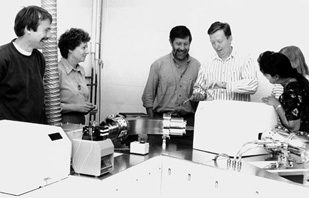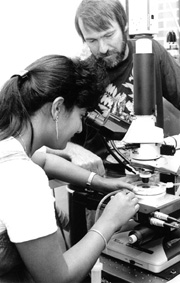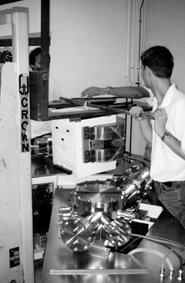Technology development program
background
The Key Centre's Research, Training and Industry Interaction programs require a high level of geochemical analytical technology, which is provided by the state-of-the-art facilities available to the Key Centre. Further development of both technology and innovative analytical and microanalytical approaches are required to meet the research aims. GEMOC is developing new analytical strategies for determining the chemical and isotopic compositions of geological materials (both solid and fluid). Special emphasis is being placed on the development of advanced in-situ microbeam methods. These developments are transmitted to industry via open and collaborative research, through technology exchange visits and workshops, and as an integral part of the training program.
The Key Centre brings together the analytical instrumentation and support facilities of the Macquarie University Geochemical Analysis Unit (GAU) and the geochemical facilities at the ANU Dept. of Geology and CSIRO Exploration and Mining. Macquarie University is a partner (with management responsibility) in the Centre for Isotope Studies housed at the CSIRO, North Ryde.
- The GAU contains:
- a Cameca SX-50 electron microprobe
- a Perkin-Elmer ELAN 5100 ICPMS
- a Perkin-Elmer ELAN 6000 ICPMS (industry collaboration)
- a custom-built UV laser microprobe attached to the ICPMS
- an automated Siemens XRF
- a LECO H2O-CO2 analyser.
- clean labs and sampling facilities to provide the infrastructure required for ICPMS and isotopic analyses of small and/or low-level samples.
- a multi-collector ICPMS under construction by NU Instruments (installed Nov. 1998 in refurbished laboratories)
- a Merchantek EO LUV laser microprobe for the MC-ICPMS (industry collaboration)
- Experimental petrology laboratories in GEMOC include piston-cylinder (9, 15 and 40 kb), hydrothermal apparatus, and controlled atmosphere furnaces; each node is well-equipped.
- The Centre for Isotope Studies provides access to state-of-the-art thermal ionisation mass spectrometers for analysis of the Rb-Sr, Sm-Nd and U-Th-Pb systems, and extraction lines and gas-source mass-spectrometers for stable-isotope analysis of fluids and minerals.
- The ANU INAX facility includes:
- a new Spectro energy dispersive XRF
- an automated Philips XRF
- Australia's only non-commercial Neutron Activation Laboratory
- atomic absorption spectrophotometry
- sample preparation facilities for mass spectrometric analysis
- access to a Cameca Camebax microprobe, ICPMS and thermal ionisation mass spectrometer facilities through the Institute of Advanced Studies.
development
the GEMOC Facility for Integrated Microanalysis (FIM)
and
Micro GIS development
GEMOC is developing a unique, world-class geochemical facility, based on in-situ imaging and microanalysis of trace elements and isotopic ratios in minerals, rocks and fluids. The Facility for Integrated Microanalysis now consists of four different analytical instruments, linked by a single sample positioning and referencing system to combine spot analysis with images of spatial variations in composition ("micro-GIS").
The Facility provides:
- The capability to image both major- and trace-element distribution in a sample, as an interpretive tool and the basis for higher precision spot analysis of trace element concentrations and isotopic ratios.
- Co-registration of images and spot data from different instruments, and use of digitized images to locate spots with a precision of better than 5 microns.
- Analytical capability for most elements of the periodic table at ppm to ppb levels.
- In-situ isotopic-ratio measurement for a range of elements, at the precision required for geologically useful results.
- New approaches to data interpretation through application of micro-GIS principles.
Micro-GIS system: A key aspect of the Facility is the co-registration of images and point analyses collected on all instruments. All data for a sample, from any of the instruments or from a bench microscope, are in the same coordinate system and can be overlaid in the computer to enhance interpretation. When fully developed, images from one instrument can be read into the computer of another instrument and used to guide the analysis. Major-element maps from EMP, or trace-element maps from the nuclear microprobe, can be linked directly to images from eg petrographic or cathodoluminescence microscopes, BSE or SEM, or to spot analyses.
Electron Microprobe, for imaging and point analysis of major and minor elements.
Scanning Nuclear Microprobe, for imaging and point analysis of trace elements at ppm levels.
Laser-ablation ICPMS Microprobe, for point analysis of a wide range of trace elements at low ppb levels.
Multi-collector Sector ICPMS with laser microprobe, for high-precision in-situ analysis of isotopic ratios.
Current status:
Electron microprobe (EMP): The existing GEMOC EMP is a CAMECA SX50, installed in 1993; it routinely produces high-precision analyses of major and minor elements with a spatial resolution of one micron, as well as high-quality images of major-element (>0.1 wt%) distribution over areas up to 45 x 45 mm, by stage-scanning with five fixed wavelength-dispersive spectrometers. In early 1999 the EMP was upgraded with an energy-dispersive X-ray detector to allow rapid and simultaneous mapping of all major elements.
Scanning nuclear microprobe (SNMP): This instrument has been built by Dr. C. G. Ryan as a separate beam line on the HIAF particle accelerator at CSIRO, North Ryde. The design incorporates several complementary types of detector, a new high-resolution probe-forming system and an innovative optical system, and provides both images of trace-element distribution and spot analyses, with a lateral resolution of 1-3 microns. When fully developed, the capabilities will include: (a) micro-PIXE: Proton Induced X-ray Emission (PIXE) using focused MeV proton beams provides non-destructive, simultaneous, quantitative microanalysis of trace elements with concentrations down to the ppm level.
(b) micro-PIGE: Proton Induced Gamma-ray Emission (PIGE) spectra can be collected simultaneously with PIXE analysis. The gamma-rays provide non-destructive analysis of light elements (eg Li, Be, B, F, Na) with detection limits of 10-200 ppm. Other nuclear reaction techniques will provide analysis of anions (H, C, O, S, Cl) which are difficult to analyse by ICPMS and EMP.
(c) CCM: In Channelling-Contrast Microscopy (CCM), MeV energy beams of alpha particles or protons are channelled into the crystal planes and axes of minerals. CCM can be used to yield images of lattice location information or to distinguish elements sited in inclusions from those in solid solution. This capability can be applied to the trace levels detected using ion backscattering, micro-PIXE and micro-PIGE.
(d) Quantitative True Elemental Imaging: The SNMP provides trace-element imaging of areas up to 2.5 mm across; these images are digitised so that any pixel or larger area can be retrieved, and analysed separately for its element concentrations. The Dynamic Analysis (DA) method developed by Dr. Ryan enables live-time assembly of true elemental images that discriminate against pile-up, inter-element overlap, background and detector artefacts such as escape peaks and tailing. Laser Ablation ICPMS microprobe (LAM): The existing GEMOC LAM was installed in December 1994 using a Perkin-Elmer ELAN 5100 ICPMS attached to a UV laser ablation microprobe, built for GEMOC by Memorial University, Newfoundland. The instrument now routinely provides quantitative analyses of >30 elements at sub-ppm levels in minerals, glasses and metals. Spatial resolution varies with the application, but typically is on the order of 30-40 microns. The LAM is fitted with a computer-driven sample stage to provide co-registration of X-Y coordinates with the other instruments.
Multi-collector LA-ICPMS microprobe (MC-LAM-ICPMS): A fully-equipped MC-ICPMS is an integral part of the Facility. This instrument combines a laser ablation microsampler, an Ar-plasma ionisation source, and a multi-collector magnetic-sector mass spectrometer, to provide high-precision in situ analysis of isotope ratios in geological materials. The MC-ICPMS also can be used in solution mode, to supplement the capabilities of the conventional mass spectrometers at the Centre for Isotope Studies.
Applications under development include:
Laser Analysis (in-situ point analysis)
- U-Pb dating of zircon, monazite, apatite
- Hf isotope analysis in zircon for crustal generation studies
- Nd isotope analysis in apatites and other REE-rich minerals
- Sr isotope analysis of carbonates, feldspars, apatites, pyroxenes
- Pb isotopes in sulfides and silicates
- Stable isotope ratios of Zn, Cu and other cations in hydrothermal systems
Solution Analysis
- Re-Os - mapping of mantle depletion ages in whole rocks and chromites
- Lu-Hf - crustal genesis, mantle metasomatism; Lu-Hf dating of garnet peridotites, eclogites, granulites
- Sm-Nd, U-Pb - faster and simpler than TIMS; simplified low-blank chemistry, no time-dependent mass fractionation, hence greater precision
 The new MC-ICPMS, November, 1998: Simon Jackson, Sue O'Reilly, Bill Griffin, Norm Pearson, Ashwini Sharma and Carol Lawson (hiding). progress in 1998
The new MC-ICPMS, November, 1998: Simon Jackson, Sue O'Reilly, Bill Griffin, Norm Pearson, Ashwini Sharma and Carol Lawson (hiding). progress in 1998
1. Facility for Integrated Microanalysis a. MC-ICPMS: A multi-collector magnetic sector ICPMS for in situ (laser-ablation) and solution analysis of isotopic ratios was installed in November. The instrument is the Nu Plasma, designed and manufactured by Nu Instruments of Wrexham, UK. Key factors in the choice were the instrument's innovative design, low potential maintenance costs and flexibility of application, combined with high sensitivity and stability. The Nu Plasma combines a double-focussing mass spectrometer with a unique fixed collector array interspersing Faraday cups and high-precision ion counters, combined with a zoom lens that allows the dispersion length of the instrument to be varied electronically for analysis of all relevant isotopic systems in dynamic or static mode. The Faraday cups are a new robust ceramic design, allowing easy and inexpensive replacement, and the electronics are designed for multiple redundancy and low maintenance costs. The instrument was producing good data only a few days after installation, and has continued to do so. Merchantek EO have provided a UV laser microprobe (see below) for use with the MC-ICPMS. An in situ laser-probe study of Hf isotopes in mantle-derived zircons was completed in January 1999 (manuscript submitted), and other projects are under way. The sensitivity and high precision of the instrument in solution mode has been demonstrated by analysis of small samples of Sr, Nd, Hf, Pb and Os.
b. Scanning Nuclear Microprobe: Construction of the beam line was completed during 1998, as scheduled, but full beam tests have been delayed due to repeated breakdowns of the HIAF accelerator at CSIRO. If repairs are completed as expected in March 1999, the beam line should be in full operation by mid-year.
c. Laser-ablation ICPMS microprobe: The laser microprobe on the ELAN 6000 ICPMS, provided by Perkin Elmer Australia (under a collaborative agreement), operated at full capacity throughout 1998, while the ELAN 5100 ICPMS was used for solution analysis. The laboratory produced large volumes of data for six PhD thesis projects, several projects carried out by international visitors, and in-house research projects. It also routinely provides data for projects related to mineral exploration (diamonds, base metals, Au), as a consulting service to the industry. Several modifications to improve sensitivity on the ELAN 6000 were carried out during 1998, including the use of He as a carrier gas. New developments included the quantitative analysis of bitumens and diamonds (see Research Highlights).
The UV laser ablation microprobe in the GAU will be reconfigured in 1999 to allow increased flexibility (eg, viewing of the sample in reflected light during ablation) and enhanced performance (shorter wavelength capability). The short wavelength option will be achieved by addition of a 5th harmonic generator, giving a new operating wavelength of 213 nm. This wavelength will provide significantly improved ablation characteristics, signal stability, ablation times and sensitivity for many minerals.
d. Software: Esmé van Achterbergh and Chris Ryan further refined the on-line version of the GLITTER (GEMOC Laser ICPMS Total Trace Element Reduction) software, our new interactive program featuring linked graphics and analysis tables, and installed it on the ELAN 6000. This package provides the first real-time interactive data reduction for LAM-ICPMS analysis, allowing inspection and evaluation of each result before the next analysis spot is chosen. It has greatly increased both the flexibility of analysis, and the productivity of the laboratory. The package is commercially available; copies have been distributed to our industrial collaborators and to Dr. Detlef Gunther's laboratory at ETH Zurich, which is cooperating in beta-testing of GLITTER. 2. Energy Dispersive XRF
The new Spectro (installed at ANU November 1996) continues to produce high-quality data. By using the polarised nature of scattered X-rays, backgrounds are reduced very substantially, and sensitivities enhanced. The instrument analyses 16 samples/day for all elements heavier than Co (ca 30) with abundances greater than ca 0.3 ppm. For elements near Z=50, such as Ag, Cd and Sn the detection limits are below 100 ppb. A large body of granite samples from SE Australia is being reanalysed specifically for Ge, Ag, Cd, Cs, Tl and Bi which were not previously measured, and to improve the data for As, Mo and Sn. The behaviour of these elements within granite suites of diverse composition is important, and precise measurement of the abundances of the heavy metals such as Mo, Ag, Cd, Sn, Sb, Hg and Bi is potentially of great interest in relating mineralisation of specific associations to various types of granites.
3. Laser development
GEMOC will benefit from a new 2-year (renewable) industry partnership with Merchantek EO, a US manufacturer of laser ablation systems, which has agreed to make Macquarie its Alpha-Test Site. Merchantek will maintain their latest model UV laser ablation sampling system, a fully programmable frequency quadrupled Nd:YAG-based system, at GEMOC and will involve us in any new technology developments into shorter wavelength ablation systems. The Merchantek system, delivered in November 1998, has been coupled to the Nu Plasma MC-ICPMS allowing high precision isotope ratio determinations to be performed on minerals in situ. The mobility of the probe will allow it to be tested on the ELAN6000 as well in a range of applications. The current microprobe delivers a 266 nm beam; a new version with a 213 nm beam is expected by mid-year.
 Simon Jackson and Ashwini Sharma adjusting sample cells on the Laser Ablation Microprobe.
Simon Jackson and Ashwini Sharma adjusting sample cells on the Laser Ablation Microprobe.
4. Centre for Isotope Studies (CIS)
The Centre for Isotope Studies (CIS) is a consortium operated by the geoscience departments of the New South Wales Universities and the CSIRO Divisions of Exploration Geoscience and Petroleum Resources using jointly-purchased mass-spectrometers housed at the CSIRO in North Ryde. The facility allows staff and students to obtain both radiogenic and stable isotopic analyses and uses technical staff jointly funded by the University members under an agreement arranged by Professor Peter Bergquist (Deputy Vice-Chancellor Research Macquarie University) and Dr Richard Flood (University Consortium Covenor). GEMOC has developed its own clean laboratories for the preparation of solutions for radiogenic isotope analysis but uses the stable isotope separation facilities at North Ryde. Staff and students of GEMOC appreciate the excellent cooperation received from the CSIRO Divisions in operating the CIS.
5. ANU Developments
Australian Earth Data On-Line AEDOL (http://aedol.anu.edu.au) provides automated processing facilities for the acquisition, harmonisation, generation and dissemination of commercially valuable spatial products including GIS datasets and geocoded images. By automating the processing, delivery and commerce of these products, AEDOL can significantly lower the cost to the user. This will drive technology take-up by eliminating transport costs and minimising delays and importantly, it will put the power of the system directly into the hands of the end-user. Funded by DIST and ACT AusIndustry.
A new Varian Ultramass ICPMS will be installed at ANU in March 1999 and will be linked to an ANU developed and constructed Helex laser ablation system (due for installation in the 2nd quarter of 1999). The Helex will be a fully automated, Excimer laser-based, micro and bulk sampling system, operating in the deep UV (193nm) where more precisely controlled ablation, as well as higher sensitivity, can be achieved for a wide range of materials. Further development of the Helex to operate interchangeably at 193nm and 157nm wavelengths is planned.

Gently does it! Andy Burrows (installing technician for Nu) supervises the placement of the 400kg magnet on the Nu Plasma MC-ICPMS.

 GEMOC ARC National Key Centre
GEMOC ARC National Key Centre